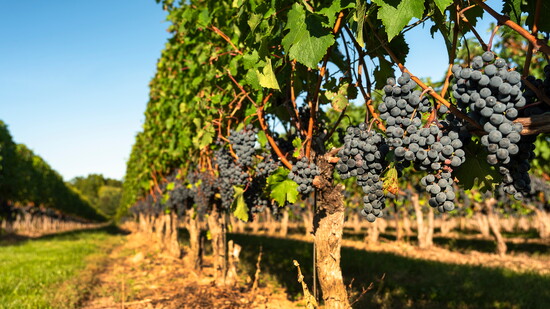Contra Costa’s conditions are ideal for grape growing. Deep, sandy soils encourage wandering root systems, soaking up water, producing small, concentrated berries with thick skins. Rolling hills lock in daytime heat, while the Carquinez Bridge channels bay breezes, bringing cold nights and cool mornings.
While Brentwood is the U-Pick capital of the world, with seasonal farms growing bounties such as strawberries, peaches, cherries, it’s in the east county where grape vines have been growing for over 100 years.
Grapes thrived in the county as early as the 1800s, with Zinfandel, Mourvèdre, and Carignane among the first plantings. The county sits on the edge of the San Francisco and Suisun bays, where the Sacramento Delta begins to weave its way inland towards Lodi. Livermore Valley is directly south of Contra Costa County.
By the early 1900s, towns like Walnut Creek, Oakley, Martinez, and Antioch were bustling, viable wine-growing towns. Grapes brought farmers great earnings. Walnut Creek was even home to the first Grape Festival in 1911.
But Prohibition in 1920 brought production to a standstill in the region. Many farmers in Walnut Creek’s Ygnacio Valley uprooted their vines and suffered without any income.
Farmers eventually planted black walnut seedlings, which led to beautiful walnut groves, only to see the industry collapse by the 1950s. This caused valley farmers to either sell off their land to developers or move to Napa and Sonoma counties.
As suburban growth took over—with the opening of the Bay Bridge and Caldecott Tunnel in the 1930s—Walnut Creek experienced a development boom. Wine-growing, however, had slow, steady upward growth.
In the 1980s, the county had a ban on agriculture, industrial, and retail on the same working site.
Becky Bloomfield, the President of the Contra Costa Wine Growers Association, says her family has been farming in the area since 1940. Bloomfield and the CC Wine Growers Association pressed the board of supervisors to ease restrictions, which they eventually did.
“We planted our first 50 acres of vines in 1995. Then planted another 180 acres, totalling 230 acres,” says Bloomfield. “We don’t have ancient vines, but there are many acres of ancient vines in the area.”
With the loosening of the ban, new wineries and tasting rooms started popping up. Then, in 2019, the CC Wine Growers Association hired a geologist to conduct a study for the region to be submitted to the federal government as an accredited American Viticultural Area (AVA).
It took four years and perseverance, and the CC Wine Growers Association was awarded accreditation as a new AVA in 2024.
This was a huge win. Bloomfield explains, “It enables the global market to recognize that the region is associated with San Francisco and Central Coast geography.” AVA has nothing to do with acres and what’s produced; it’s geographic. The AVA adds value to regions where grapes are grown.
Some newer plots are producing Chardonnay, Sauvignon Blanc, Merlot, Petite Syrah, and niche grapes. Starting with this year’s harvest, you may notice AVA on wine bottle labels and more language around “Central Coast” and “Contra Costa” for more premium branding.
From family-owned indie labels to storied estates, the county is having another wine boom, celebrating its local history.
“Roaming Legend is more than a new wine brand, it’s a bold expression of our heritage and vision,” said Jordan Wente, ambassador for Roaming Legend and fifth-generation winegrower. “These wines embody the spirit of adventure that defines the Livermore Valley.”
From cave tours at Wente Vineyards to a spring trolley wine tour in Brentwood, winery visits, tasting rooms, and family events, Contra Costa County is enjoying a new boom that celebrates both its history and its future, and brims with vinophile adventures!
Visit: ccwinegrowers.com
“It enables the global market to recognize that the region is associated with San Francisco and Central Coast geography.”
